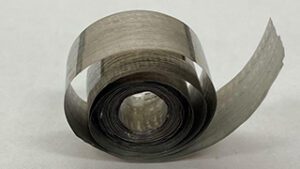 Tech startup, Nanode, has developed a low-cost tin foil anode technology for lithium-ion and sodium-ion batteries to increase volumetric energy density up to 50% while saving up to 60% on raw material costs and processing costs.
Tech startup, Nanode, has developed a low-cost tin foil anode technology for lithium-ion and sodium-ion batteries to increase volumetric energy density up to 50% while saving up to 60% on raw material costs and processing costs.
Tin has a greater volumetric energy density than the traditional copper-graphite anode combination, meaning the tin anode can be approximately five times thinner. Tin can actively store lithium ions, whereas copper can only be a conductive support. This reduces both the size of the cell and the cost of raw materials.
At the same time, there are opportunities for savings in processing costs. The Nanode product is made with a simple one-step melt-spinning technique, easily scalable commercially, as shown in the video below. This is significantly less expensive than the multi-step processing of other lithium-ion anodes, often requiring complex nanotechnologies.
The new technology is initially aimed at batteries for the consumer electronics market, with high potential demand and wide margins. Nanode’s thinner anodes make it ripe for technologies in which volume is hypercritical – such as the wearables market, currently experiencing a double-digit annual growth.
The startup has a pilot plant at the University of Alberta, Canada from where it was spun out in spring 2020. Early data coming from pilot customers using microbatteries is promising, validating increases in energy density and compatibility with jelly-roll battery structures. A framework purchase agreement for an initial supply is in place after third-party validation.
Nanode is reportedly ‘firing on all cylinders’ to improve the cycle life of the technology, with 500 cycles being their target for consumer electronics. Currently the cycle life of their batteries are one hundred and two hundred cycles for lithium and sodium batteries, respectively. This will be achieved by optimising electrolyte chemistry with the tin foil anode, using machine learning to find the perfect match.
Our view: ITA has been closely tracking R&D on tin foil anodes for lithium-ion batteries and are keen to see this first example of commercial ramping. This anode variant is of particular interest to the tin industry as it has the highest tin content.
The simplicity and large-scale nature of melt spinning makes this low technology approach particularly attractive, with previous interest in similar tin metal variants in India and China. Once Nanode achieves cycle life targets and potentially gains traction in the EV sector, this could result in a significant new use for tin.
ITA Report – Tin in Lithium-ion Batteries, Jan 2019
